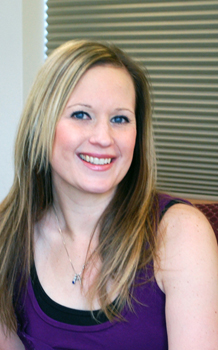Dance is a means to convey faith without words
As Karla Parbon follows her calling to share her Christian faith with others, she usually does it without words.
“Dance allows me to share my faith through movement versus through words,” she said. “In our culture, so much is about words and imposing our words and ideology on others. Through dance, we don’t impose. We allow people to experience the Holy Spirit without speaking a word.”
 |
| Karla Parbon connects dance with faith |
While she now uses dance to “accentuate, express and further develop faith,” Karla did not always see things that way. She grew up dancing. As a four year old, she danced with tap shoes and a tutu.
Growing up in a Pentecostal church, however, her faith and her dancing were separate.
“We didn’t dance in church,” she said. “We could dance in a studio, but to connect dance and church was inconceivable.”
Now, though, she not only brings her faith and her passion for dance together, but also helps others connect the two.
In elementary school, Karla added jazz dance to her repertoire. Then she realized ballet was necessary to a good dance technique.
By the time Karla finished high school, she was burned out from years of competitive dance. For 15 years, she danced for three to six hours a day about five days a week. So she chose to go to Whitworth University instead of pursuing dance.
Miserable without dance, Karla and some other students, led by Penny Slack, decided to bring dance to Whitworth. They started Jubilation, a student-led dance program that continues to thrive. Karla and others taught dance classes for one another.
In Jubilation, participants emphasized the joy of dancing for value and self-worth, not competing. In high school, Karla had defined herself by whether she placed first in competitions or was the best dancer in the class.
“I experienced a shift. It needed to happen for me to fall in love with dance again,” she said.
As she began to connect dance to faith, she began developing as an artist under the guidance of Judy Mandeville, who supported students as they started Jubilation and served as its faculty advisor.
She taught dance at Whitworth in partnership with Margaret Taylor Doane, a pioneer in sacred dance nationally.
After graduating in 2000 with a bachelor’s in psychology, Karla taught dance at Gonzaga Prep and worked with some Gonzaga University student interns.
When she learned that Suzanne Ostersmith, the dance program director and instructor at Gonzaga University was forming dance programs at Gonzaga and Whitworth, Karla emailed Suzanne and they met.
Suzanne asked her to teach a class. Soon it turned into multiple classes. When Suzanne decided to focus on Gonzaga, she asked Karla to become dance program director at Whitworth.
There she has pioneered multiple classes, including one on ministry and choreography, which allows students to explore the connection of dance to faith and to develop skills to choreograph dances that express faith-based concepts.
This year she took a group to an American College Dance Festival Association event to perform a dance based on the writings of Saint Teresa of Avila. She also choreographed a dance for her Jazz II course to raise awareness about human trafficking in support of Unite, a student-led human trafficking awareness movement at Whitworth.
Along with working with students, Karla earned her master’s degree in theology from Whitworth University in 2012. With support from faculty, she tailored her master’s program to create a movement-infused theology experience, combining her passion for dance and faith.
That joint passion was also evident when she pioneered the dance ministry at Life Center Church, which she has attended for 18 years.
She contacted Paul and Amy Miller, who are worship leaders and creative arts directors at Christian Life Center, and volunteered her services with dance.
Amy said she had been praying for 10 years, both for Life Center to be open to a dance ministry and for someone to lead it.
Karla’s first performance for the 2006 Easter service met with “overwhelming support.” Since then, she has prepared two to four pieces a year.
Dancers from a variety of experience and dance genres—hip hop to contemporary to ballet—audition to participate in this ministry.
“Every genre can be used for the glory of God,” Karla said.
Having this ministry helps alleviate the tension many Christian dancers feel between their faith and their art.
“Since the Reformation, Christians have been fighting against the idea that the body is of the devil,” Karla said.
Dance was often portrayed as lewd, and women especially are suspected of using their bodies to tempt the community away from a righteous way of life, she said.
“That’s a struggle many Christian dancers have had to work through,” she said. “Many worry dancing celebrates their bodies. They forget that God created their bodies, and dance can be a way for them to praise God.”
As she and the dancers create pieces, they are cautious about what they do and what they wear because, while most of the comments are positive, some people are still apprehensive. Because interpretation is a factor in art, some may not receive it well.
While it is difficult to please everyone, “we go into every performance knowing we’re doing things as ethically and morally as we can,” Karla said.
The ministry can help the dancers connect their faith with something concrete: their bodies. It helps them move their spirituality out of their heads and fully embody it, she said.
Developing skills as dancers for this embodiment goes beyond the dancers’ personal learning and growth. As dancers learn to express their faith with all their being, they have a tool to communicate.
On stage, dancers allow themselves “to be vessels, disciples and witnesses for the Lord,” she said.
For information, email kparbon@whitworth.edu.
Copyright © May 2013 - The Fig Tree




